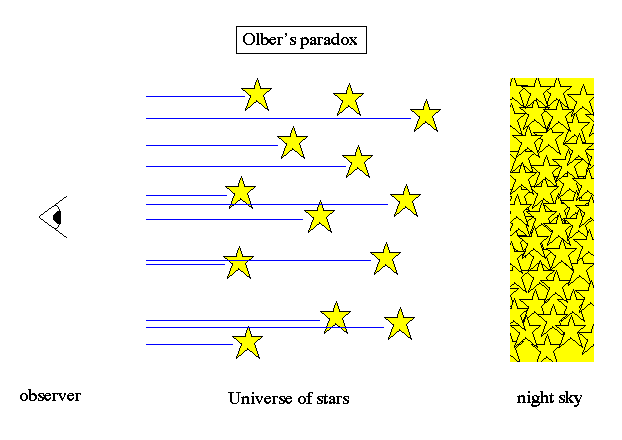
The oldest cosmological paradox concerns the fact that the night sky should not appear dark in a very large (or infinite), ageless Universe. It should glow with the brightness of a stellar surface.

There are many possible explanations which have been considered. Here are a few:
The premise of the second explanation may technically be correct. But the number of stars, finite as it might be, is still large enough to light up the entire sky, i.e., the total amount of luminous matter in the Universe is too large to allow this escape. The number of stars is close enough to infinite for the purpose of lighting up the sky. The third explanation might be partially correct. We just don't know. If the stars are distributed fractally, then there could be large patches of empty space, and the sky could appear dark except in small areas.
But the final two possibilities are surely each correct and partly responsible. There are numerical arguments that suggest that the effect of the finite age of the Universe is the larger effect. We live inside a spherical shell of "Observable Universe" which has radius equal to the lifetime of the Universe. Objects more than about 15 billion years old are too far away for their light ever to reach us.
The resolution of Olber's paradox is found in the combined observation that 1) the speed of light is finite (although a very high velocity) and 2) the Universe has a finite age, i.e. we only see the light from parts of the Universe less than 15 billion light years away.
Copernican Principle:
The Copernican Principle is a basic statement in physics that there should be no ``special'' observers. For example, the Aristotelian model of the solar system in the Middle Ages placed the Earth at the center of the solar system, a unique place since it ``appears'' that everything revolved around the Earth. Nicolaus Copernicus demonstrated that this view was incorrect and that the Sun was at the center of the solar system with the Earth in orbit around the Sun.
The implications of Copernicus' work can not be exaggerated. His views challenged the literal interpretation of Scripture, the philosophical and metaphysical foundations of moral theory, and even common sense itself. The result was a massive opposition to his reported ideas. It was the slow, sure acceptance of the heliocentric theory by natural philosophers that ultimately quieted the general clamor, however the name of Copernicus is still a battle cry against the establishment in religion, philosophy and science. In later years with Freud, man lost his Godlike mind; with Darwin his exalted place among the creatures of the Earth; with Copernicus man had lost his privileged position in the Universe.
The lesson learned by future scientists is that if a theory requires a special origin or viewpoint, then it is not plausible. Almost all cosmological and scientific theories are scrutinized by the Copernican principle. Often interpreted that is an idea requires some special condition, then it is incomplete.
Isotropy and Homogeneity:
The Copernican principle, when applied to cosmology and the structure of the Universe, basically asks the question of whether the Universe is isotropic and homogeneous. These two terms are not equivalent and have a special meaning to cosmology. Isotropy means there are no special directions to the Universe, homogeneous means there are no special places in the Universe.
Again, while these two definitions appear similar, they describe very different properties to the Universe as a whole. For example, if the Universe is isotropic then this means you will see no difference in the structure of the Universe as you look in different directions. When viewed on the largest scales, the Universe looks the same to all observers and the Universe looks the same in all directions as viewed by a particular observer. Homogeneity, when viewed on the largest scales, means that the average density of matter is about the same in all places in the Universe and the Universe is fairly smooth on large scales.
Notice that this is clearly not true for the Universe on small scales such as the size of the Earth, the size of the Solar System and even the size of the Galaxy. Terms such as look the same and smooth in density are applied only on very large scales. For cosmology, we only consider the isotropy and homogeneity of the Universe on scales of millions of light-years (the distance it takes light to travel in one year, is roughly 1018 cm) in size.
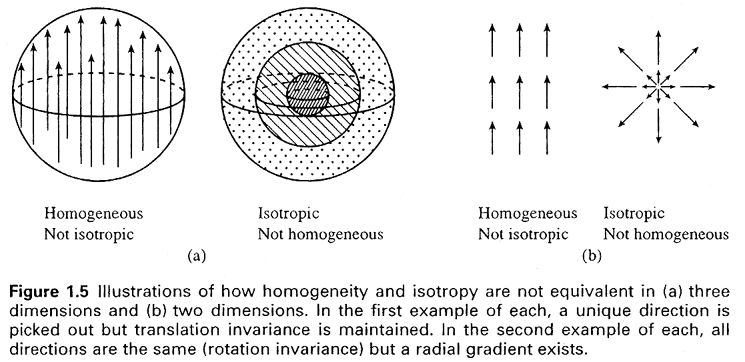
An isotropic Universe also means that there is no `center' to the Universe. The rotation of the Earth produces a unique orientation (i.e. north and south poles), but the Universe appears the same from any position. This is an important point when we consider the origin of the Universe known as the Big Bang. Due to isotropy, there is no `place' where the Big Bang occurred, there is no center point. Empedocles stated it best by saying `God is an infinite sphere whose center is everywhere and circumference nowhere.
Cosmological Principle:
Observations to date support the idea that the Universe is both isotropic and homogeneous. Both facts are linked to what is called the cosmological principle. The cosmological principle derives from the Copernican Principle but has no foundation in any particular physical model or theory, i.e. it can not be `proved' in a mathematical sense. However, it has been supported by numerous observations of our Universe and has great weight from purely empirical grounds.
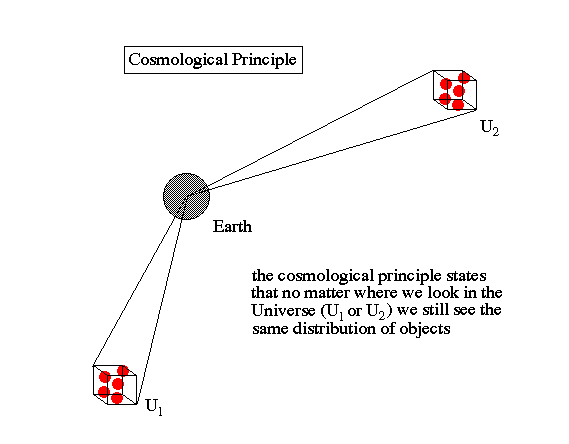
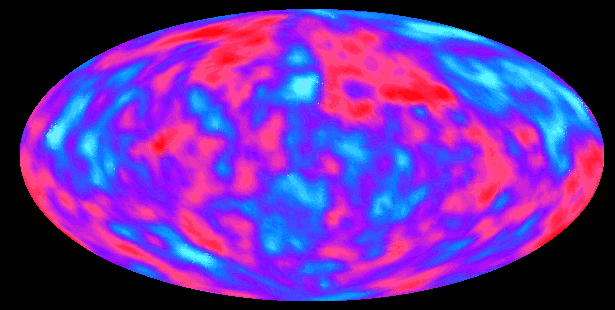
The greatest consequence of the cosmological principle is that it implies that all parts of space are causally connected at some time in the past (although they may no longer be connected today). Thus, a homogeneous Universe leads to the conclusion that the whole Universe appeared at a single moment of time, a Creation.
Lastly, we is we extend the cosmological principle through time we have the `perfect' cosmological principle, that the Universe is isotropic and homogeneous, and has been for all time. This means that the laws of Nature are unchanging and that things we observe from the past can be assumed to operate under that same physics as things toady.
Lookback Time:
The large size of the Universe, combined with the finite speed for light, produces the phenomenon known as lookback time. The speed of light (299,790 km/sec) is very fast, but finite. For any phenomenon on the Earth's surface, the distances are small enough that light signals appear instantaneous. However, the distances in space are vast. And, in particular, the distance between galaxies are measured in hundreds of millions of light-years. Thus, the time for light to travel from distance galaxies is on the order of hundreds of millions of years up to billions of years for the most distant objects.
Lookback time means that the farther away an object is from the Earth, the longer it takes for its light to reach us. Thus, we are looking back in time as we look farther away.
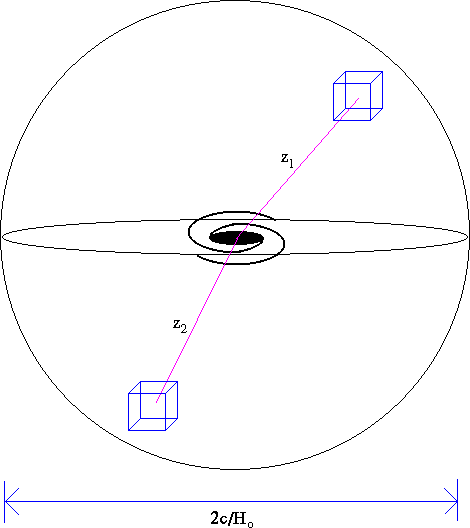
This effect can be of an advantage to astronomers. The more distant an object, the farther in its past we are observing its light. Combined with the cosmological principle, the fact that the Universe is homogeneous at all points and all times, then the finite speed of light means that observation so distant galaxies are equivalent to lookback time. Lookback time is what makes the subfield of galaxy evolution possible, the ability to study the changes in galaxies with time by observing them at various distances means equals different epochs.
Cosmic Edge:
One of the first cosmic riddles is `Is there an edge to the Universe?' This question illuminates one of the common problems in dealing with cosmological issues. By definition, all discussion of the characteristics of the Universe must face the fact that the Universe has to contain the properties of everything. Thus, the term `edge' of the Universe assumes that there exists something that is not contained in the Universe. Invoking an outside property the the Universe (an edge or outside to the Universe) is logically inconsistent since, by definition, the Universe must contain everything.
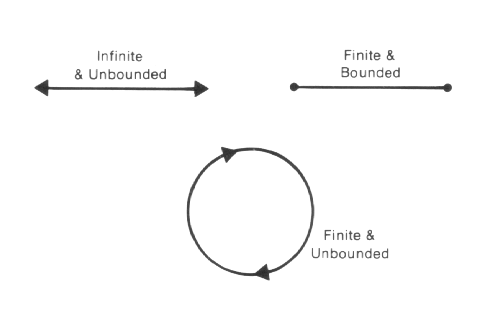
A corollary to this point is that the Universe must be boundless. This does not necessary mean that the Universe is infinite, although this is the simplest solution. Notice also that space is not a receptacle for the Universe, space is physical and is contained with the Universe. Lastly, if the Universe contains everything, the it must contain its own origin mechanism, a bootstrap program.